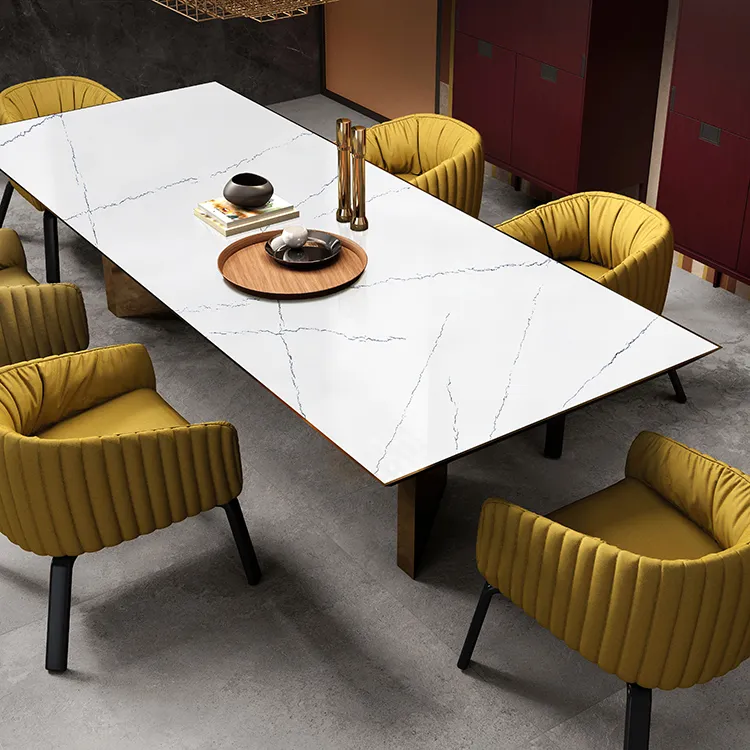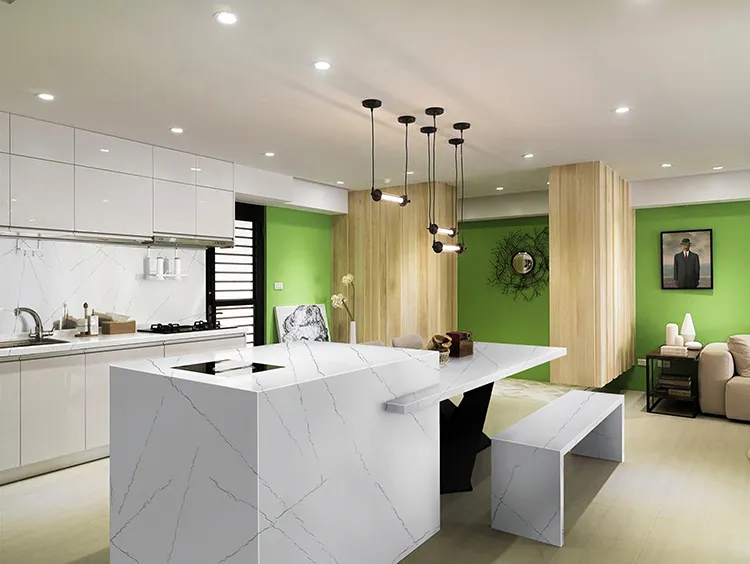Quartz stone worktop has become one of the most widely used materials in modern kitchen and bathroom spaces due to its high hardness, corrosion resistance, scratch resistance, low color penetration, and easy cleaning. However, no material is perfect. Even a material with superior performance such as quartz stone benchtop has certain physical and chemical limitations.
One of the most prominent weaknesses is that it is prone to cracking and discoloration under long-term high temperature conditions. Although this weakness is not easy to be discovered in daily use, once it is used improperly, it is very likely to cause irreversible damage to the aesthetics and structural integrity of the quartz stone benchtop.
This article will focus on the core question of "What are the weaknesses of quartz stone benchtop?" and systematically analyze the material structure and thermal stability of quartz stone worktop, as well as why it is prone to cracking and discoloration under long-term high temperature. We will start from multiple professional dimensions and comprehensively analyze the formation mechanism and potential impact of this phenomenon.

Basic composition structure of quartz stone benchtop
In order to understand its performance under high temperature, we must first understand the basic composition structure of quartz stone benchtop. Quartz stone is a composite artificial stone, usually composed of the following components:
1. Natural quartz sand (about 90%-93%)
Natural quartz has extremely high hardness and corrosion resistance, and is the main structural skeleton of quartz stone worktop.
2. Polymer resin (about 7%-10%)
Resin is the key bonding material for bonding quartz sand particles into shape, and has certain flexibility and bonding strength.
3. Pigments and additives (about 1%-3%)
Used to provide rich colors and textures, making quartz stone worktop more visually decorative.
Quartz stone worktop is made by pressing these components under high temperature and high pressure, and then refining them through grinding, polishing and other processes. Its physical properties, especially in terms of temperature resistance, largely depend on the type and content of resin.

Why can't quartz stone benchtop be exposed to high temperatures for a long time?
Although the natural quartz in the quartz stone worktop has a melting point of over 1600℃ and theoretically has extremely strong heat resistance, it also contains organic polymer resins. This component determines that the heat resistance of the quartz stone benchtop is not unlimited.
1. Limited heat resistance of resin
• Common polyester resins and acrylic resins usually have heat resistance temperatures between 80℃ and 120℃;
• When exposed to temperatures above this temperature for a long time, the resin will undergo chemical reactions such as softening, decomposition, and carbonization;
• Once the resin structure is damaged, the bonding strength between the quartz particles will decrease, forming microcracks or even fractures.
2. Uneven thermal expansion and contraction lead to structural stress
The thermal expansion coefficients of quartz particles and resins are different. When they are exposed to high temperatures, the thermal expansion amplitudes are inconsistent, which easily generates structural stress inside the countertop. When a local area is repeatedly heated (such as direct contact with the bottom of a pot), it is very easy to induce stress cracking on the surface or inside of the countertop.
3. Instability of pigments and additives
Inorganic or organic pigments used for coloring may undergo chemical changes at high temperatures, resulting in color changes, such as yellowing, graying, and blackening, especially in light-colored quartz stone worktops.
Mechanism analysis of "cracking" caused by high temperature in quartz stone worktop
Quartz stone worktops crack under long-term or repeated high temperature conditions, mainly manifested as: local cracks, through cracks, or corner cracks. Its formation mechanism can be analyzed from the following aspects:
1. Structural damage caused by concentrated thermal stress
When a heat source (such as a hot pot, oven heat dissipation port, etc.) directly contacts a certain point on the quartz stone benchtop for a long time, a "hot spot" will form in the area, causing the temperature of the local area to rise rapidly, while the temperature of the surrounding area remains relatively low. The resulting temperature difference will form a huge thermal stress difference inside the quartz stone benchtop. The resin layer softens at high temperatures, while the quartz particles remain rigid, causing the bonding layer to tear or even break, thus forming cracks visible to the naked eye.
2. Thermal fatigue leads to microcrack accumulation
If the quartz stone benchtop is in a state of alternating hot and cold for a long time (for example, a hot pot is quickly wiped with cold water after being touched), it will repeatedly induce thermal expansion and contraction of the material, and small cracks will be generated at the interface between the resin and the quartz particles. These microcracks are not easy to detect at the beginning, but they will gradually expand under the stimulation of continuous high temperature, and eventually form structural damage.
3. Uneven support structure leads to concentrated force
If the bottom support of the quartz stone benchtop is uneven or improperly installed, the stress generated by thermal expansion and contraction cannot be reasonably released, and cracks are easily formed in weak structural areas (such as the edge of the sink and around the stove).
Analysis of the reasons for "discoloration" caused by high temperature of quartz stone worktop
In addition to cracking, another weakness of quartz stone benchtop under high temperature is discoloration. The main manifestations of discoloration are:
• The countertop turns yellow, darkens, and loses its original luster;
• The color of the local area deepens or becomes mottled;
• The original texture structure of the quartz stone benchtop is blurred.
The main reasons include:
1. Resin oxidation decomposition
In a high temperature environment (especially above 120°C), the resin undergoes thermal oxidation reaction, resulting in a color change reaction, the most typical manifestation of which is yellowing. This is a physical sign of resin aging.
2. Thermal decomposition of additives
Organic pigments or fillers used to improve color may decompose or react chemically with other components under high temperature, resulting in color distortion.
3. Surface coating damage
Some quartz stone worktops add a trace amount of anti-seepage coating when leaving the factory to improve anti-fouling performance. When high temperature destroys these protective films, the surface is prone to adsorb pollutants such as oil stains and water stains, resulting in visual "discoloration".

The true performance range of quartz stone benchtop's heat resistance
In order to more clearly define the heat resistance of quartz stone worktop, we can summarize the following core points from experimental data and industry standards:
| Item | Performance range of quartz stone worktop |
| Temperature that can be tolerated for a short time | Below about 150℃ |
| Temperature that can be safely used for a long time | Recommended not to exceed 110℃ |
| Temperature that is at risk of continuous contact with heat sources | Above 180℃ (very easy to crack or discolor) |
| Danger of placing a hot pot directly | High, may instantly cause local deformation or cracks |
Therefore, even if quartz stone worktops show good high temperature resistance in daily use, their fragility under long-term high temperature cannot be ignored. Especially in kitchen environments where frying pans, induction cookers, ovens, kettles and other equipment are frequently used, it is even more necessary to strengthen the protection of the countertop.
How to avoid damage caused by high temperature of quartz stone benchtop?
After understanding its weaknesses, reasonable measures should be taken to avoid damage to quartz stone benchtop caused by high temperature. The following are some practical suggestions:
1. Use insulation pads
Before placing high-temperature pots, baking trays and other items, be sure to use silicone, wooden or metal insulation pads to avoid direct contact between the heat source and the quartz stone worktop surface.
2. Avoid concentrated high-temperature contact
The heat dissipation outlets of equipment such as induction cookers and ovens should be away from the edge of the countertop to avoid concentrated heating of local areas.
3. Cleaning methods should be appropriate
Never use cold water to clean the countertop immediately when it is at high temperature to prevent thermal shock cracking due to sudden changes in temperature.
4. Design a reasonable heat source layout
In the early stage of kitchen design, a reasonable spacing should be reserved to ensure that there is a buffer space between the heat source and the quartz stone worktop.
What is the real weakness of quartz stone worktop?
In summary, although quartz stone benchtop performs well in terms of scratch resistance, stain resistance and decorativeness, it is essentially a "composite material" and its high temperature resistance is limited by the thermal stability of its internal resin components. Once exposed to high temperature for a long time, the following problems are very likely to occur:
• Softening of resin, decreased bonding strength, leading to structural cracking;
• Accumulation of thermal expansion and contraction stress, causing corner or local fractures;
• Decomposition of resin and pigment, irreversible discoloration on the surface;
• High temperature destroys the protective coating, reducing the overall beauty and durability.
Therefore, the question raised in the title can be clearly answered:
The weakness of quartz stone benchtop lies in its limited tolerance to high temperatures. Under the influence of long-term or continuous high temperatures, cracking and discoloration are very likely to occur, which is the most important issue to pay attention to when using it.
Only reasonable use and scientific maintenance can truly bring into play the strengths of quartz stone worktop and avoid its double damage to structure and appearance due to high temperature.
When it comes to sourcing premium building materials, Rongguan stands out as a trusted manufacturer and supplier. Our diverse range of products includes quartz countertops, artificial marble, and terrazzo flooring, designed for both residential and commercial projects. With over 10 professional production lines in our Foshan factory, we guarantee high output and consistent quality. Serving markets in North America, Europe, and beyond, we offer competitive wholesale prices, exclusive promotional deals, and tailored customization. Choose Rongguan for materials that combine innovation, quality, and affordability.

